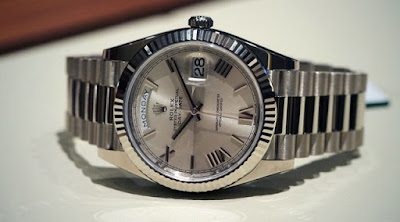The New Watch Of Presidents: The Rolex Day-Date 40 Replica Watch
What a difference a millimetre makes. In its new launches this year Rolex has been addressing the issue of sizing, including the introduction of a 39mm entry-level Oyster Perpetual, and an adjustment in the Day-Date arena that, while different by just one millimetre in diameter to the previous model, is symptomatic in its way of a larger evolutionary change. Hence they put it in the name of the watch: the Day-Date 40 is so-called because it’s 40mm wide.
The movement
Oh – and it has a stonking new movement too: it’s twice as accurate as COSC-certified chronometer status requires; it raises the power reserve by almost a full day, from 48 hours on the Day-Date II to 70 hours, and it has all the advantages of durability and anti-magnetism we expect from Rolex – plus a mere 14 patents packed into its design.
However, let’s talk proportions and style. The Day-Date 40 is being introduced as a replacement to the 41mm Rolex Day-Date II , a watch that was introduced in 2008. In its seven-year lifespan Day-Date II has been a more outré alternative to the slightly effete (by modern standards) 36mm Day-Date, and though it evolved, the Day-Date II was (in our opinion) a watch of its time: rather plump, distinctly showy, and just not that elegant. Its proportions seemed overplayed on every front, from its overall diameter to the fat, fussy Roman numerals.
In the modern Rolex line-up, with the 36mm Day-Date now existing in rather eccentric styles – coloured dials and straps, jewelled dials and the like – something that brought sophistication and refinement back to the "watch of presidents" has been long overdue. Reduced by a mere millimetre but also streamlined in shape and style, this is exactly what the Day-Date 40 does.
In the modern Rolex line-up, with the 36mm Day-Date now existing in rather eccentric styles – coloured dials and straps, jewelled dials and the like – something that brought sophistication and refinement back to the "watch of presidents" has been long overdue. Reduced by a mere millimetre but also streamlined in shape and style, this is exactly what the Day-Date 40 does.
The Day-Date was introduced in 1956 as the senior, smartest watch in the Rolex collection, only to be made in precious metals, with a nifty new calendar display that showed both the day of the week and the date in the month, both of which were adjustable from the crown. In the 1970s the “quickset” system was brought in, which made this adjustment much more straightforward. The watch became associated with leadership around the world, particularly with American presidents, and its famous bracelet with semi-circular links became known as the President bracelet (and some refer to the braceleted Day-Date itself as simply the Rolex President).
The Day-Date 40 brings elegance back to the Day-Date story, along with an improved version of the President bracelet itself. Traditionally, the bracelet was constructed from gold links inside which are steel bars. In the new version, these steel bars sit within ceramic sleeves, which simply increases durability by lessening the wear-and-tear from soft and hard metals rubbing up against each other. A small development, perhaps, but a groundbreaking one that is all about end quality. That’s just so very Rolex.
The Day-Date 40 brings elegance back to the Day-Date story, along with an improved version of the President bracelet itself. Traditionally, the bracelet was constructed from gold links inside which are steel bars. In the new version, these steel bars sit within ceramic sleeves, which simply increases durability by lessening the wear-and-tear from soft and hard metals rubbing up against each other. A small development, perhaps, but a groundbreaking one that is all about end quality. That’s just so very Rolex.
There are four versions of the Rolex Day-Date 40 replica watch, in platinum, rose gold (or Everose if you prefer), yellow gold and white gold. Compared to the Day-Date II, the new Rolex Day-Date 40 is more streamlined, with longer, slimmer lugs and a thinner bezel. Interesting geek fact alert: it even has thinner notches in fluted bezel versions. Whereas the Day-Date II bezel has 70 notches, the Day-Date 40 has 76.
Crucially, besides the shape and proportions of the watch, dial details have been refined. Fat, serif Roman numerals (along with those swivelling Arabic numerals on past Day-Date II models) are a receding memory as far as Day-Dates are concerned. Single applied hour markers are featured on the platinum, rose and white gold models, while the yellow gold has a much more minimal approach to Roman numerals.
The dials
The dials are nothing short of sensational. Rolex has been working on its laser etching techniques, to deliver dial textures – etched patterns on a sunray surface – that have complexity, depth and considerable subtlety. Move them around in the light and they take on repeatedly different looks.









Comments
Post a Comment